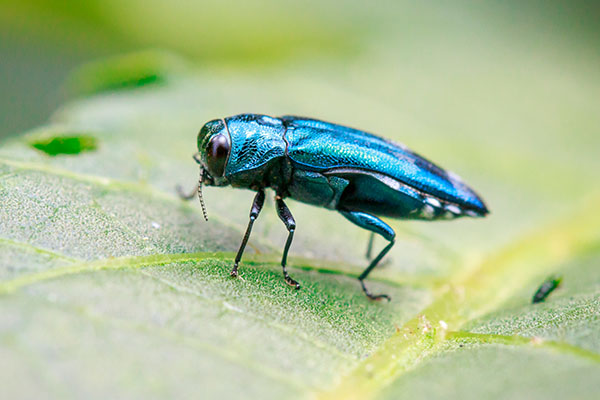Contents
Insects can ruin the most beautiful trees and shrubs in your yard. These little pests can cause big damage, even killing trees, especially if left unchecked.
Preventing bugs from attacking your trees and shrubs altogether may not be possible, but with the proper treatment techniques, you can minimize the damage and promote healing for the next growth phase.
The first step to protecting your landscaping is to identify the types of pests you’re dealing with. Different bugs require different treatment techniques and specialized insecticides that fight them off.

Common insects to look out for in Michigan
- Aphid
- Eastern Tent Caterpillar
- Emerald Ash Borer
- Japanese Beetle
- Gypsy Moth
- Spider Mites
After you’ve identified the types of insects attacking your shrubs and trees, you can begin to determine the right kind of treatment you need. Read on to get more information about some of the most common insects in Michigan and how to protect your trees and shrubs from these pests.
Aphids
Aphids come in several species and colors and can affect just about every shrub and tree in Michigan. They feed on the juice of a plant, damaging the leaves and stems in the process. Plus, they can attract other pests like wasps, ants, or flies.

- Leaf curling
- Leaf discoloration
- Stem distortion
Eastern Tent Caterpillar
The Eastern Tent Caterpillar attacks a variety of shade and fruit trees, including apple, cherry, crabapple, chokecherry, and more. They create silky nests, or “tents,” in the fork of branches and can defoliate the tree’s leaves. While the damage may seem severe, your trees or shrubs are usually able to recover during the next growing season.

Emerald Ash Borer
As the name suggests, the Emerald Ash Borer, or EAB, specifically targets Ash trees. They have caused the death of millions of Ash trees across Southeast Michigan, Northwest Ohio, and across North America.
- A thinning canopy, starting at the top of the tree
- Yellowing and browning of leaves
- Splits in the bark or large strips falling off
- D-shaped exit holes through the bark
- S-shaped galleries below the bark where larvae feed

Japanese Beetle

The Japanese Beetle has around 300 different species that feed on trees and shrubs like linden, hydrangea, apple, birch, roses, crape myrtle, black walnut, and more. You can tell Japanese Beetles have been feeding on a tree or shrub by the damage they leave behind. Their chew marks create a lace-like pattern on the plant’s leaves and they usually feed in groups. Depending on the level of infestation, Japanese Beetles can defoliate a tree in just a few weeks.
Gypsy Moth
Gypsy Moths are an invasive pest native to Europe. They have become notorious for destroying hardwood trees in Michigan and most of the Northeastern United States. The large, hairy caterpillars typically prefer to feed on oak trees, but are known to feed on other hardwoods like aspen, willow, birch, and even conifers like spruce and pine.
Spider Mites
A common pest in Southeast Michigan and the surrounding areas, there are several species of Spider Mite. They got their name due to their ability to produce a silken web-like material, similar to a spider. Check leaves for discoloration and a dry, brittle texture to assess the level of damage. Depending on the size of the infestation, damage can range from minimal to entire leaves being stripped and killed.

Spider Mites affect a wide range of trees and shrubs, including:
- Arborvitae
- Hydrangea
- Magnolia
- Maple
- Pine
- Spruce
- Juniper
- Elm
- Tulip
- Walnut
- and more
Protect Your Trees And Shrubs
From Insects with Expert Help
There are some precautions and maintenance steps you can take to help prevent insect infestations in your trees and shrubs. These techniques include proper planting, regular grooming, and sufficient watering.
While these can help feed and protect your shrubs and trees, they are often not enough. This is where insecticides come in. There is no one-size-fits-all solution when it comes to insecticides and controlling pests in your landscaping. You need to make sure to use insecticides that target the specific bugs you are dealing with—otherwise, you may be wasting time and money, and doing more harm than good.
The professionals at Contender’s are here to help. We can identify the types of insects that are attacking your trees and shrubs and develop a plan that implements correct, safe techniques to help you protect and feed your shrubs and trees.
If you think you have an insect problem, contact us using the button below for your free estimate.

